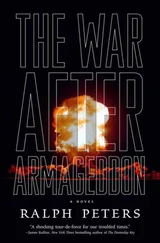“Are you finished?”
“No. Give me more ships and planes, even if you have to strip the north bare to throw everything we have into the Barents.”
“I can’t do that. You will have to make do with what you have.”
Grishkov stared at Stashinsky.
Stashinsky ignored Grishkov’s hard gaze. “Another thing: When you find the K-363, she is to be captured, not sunk. Is that clear?”
Grishkov looked at his boss in disbelief. “Who decided this? The Kremlin? I thought we had agreed that we will not negotiate with terrorists.”
“No one has suggested negotiating with them. Anyway, those are the President’s orders. And I agree with him that it would be useful to know what Zakayev’s organization is up to.”
“Capture them, eh?” Grishkov said dolefully.
Stashinsky, as if intrigued by the possibilities Zakayev’s capture had raised, said, “Does the K-363 have scuttling charges on board?”
“No, they were removed from all of our submarines to prevent a disgruntled crewman from setting them off while in port or even on patrol. We’ve arrested a number of conscripts who have threatened to set them off. It seemed the prudent thing to do.”
“In that case what would you do, drop a net over the K-363 and haul her up like a fish?” “Perhaps. But I was thinking of something a little more sophisticated. Like the Kursk recovery.”
“I don’t understand.”
“If we can find her, keep her down, drive her into shallow water, we may be able to bring in a heavy lift ship.”
Grishkov pointed to the painting of the Kursk, hanging over the fireplace. An Oscar II—class cruise- missile attack submarine, the Kursk, under the command of Kapitan First Rank Gennady P. Liachin, sank when one of her own torpedoes exploded. A colossal disaster for the Russian Navy, the submarine, with 118 men aboard, sank in the Barents Sea. Months later a heavy lift ship recovered the hulk and brought it home.
Stashinsky turned his gaze from the painting of the Kursk to Grishkov. “You have your orders, and I have a meeting with the President later today.”
“Then, with your permission, Admiral…” Grishkov said frostily.
Stashinsky went to his desk and buzzed his aide who immediately brought Grishkov’s things.
“The K-480,” Stashinsky called as Grishkov departed. “I want the Amerikanski, Scott, out of the Barents Sea and off that submarine.”
“They’re on our ass and closing in,” Litvanov said.
He’d ordered baffles cleared to the right and sonar had picked up the two Norwegians dead astern. Moving closer inshore was not an option: The K-363’s keel was virtually scraping bottom.
“Twenty degrees right rudder,” Litvanov ordered.
“Twenty degrees, aye,” answered the helmsman.
Litvanov wiped his face on a sleeve. He glanced at the compass repeater, its lubber’s line on 240 degrees. He waited a beat, until the line indicated 245, then ordered, “Meet her.”
“Aye, meet her.”
The helmsman shifted the rudder to check the K-363’s swing to the right.
“Steady as you go,” Litvanov ordered.
“Aye, steady on two-five-zero degrees.”
Again, Litvanov dabbed his face. He sought Zakayev. “We’ll hold this course and let them pass across our stern as we move away.” He looked at the girl. She appeared calm, but Litvanov knew she had butterflies in her stomach. They all did. “We’ll be all right,” he told her.
“I know that,” she said. “I’m not scared.”
“Fire Control,” from Litvanov.
“Targets steady on course two-one-eight. Speed ten. Range five kilometers.”
Zakayev, familiar now with the complexity of the CCP, looked at the digital pitometer log that showed the K-363’s speed through the water: three knots. Just enough speed, Litvanov had explained, to maintain control of the ship against setting currents while running ultraquiet.
The girl heard it first, coming through the hull, and cocked her head to listen.
“Screws,” said Starpom Veroshilov, looking up as if trying to see what might await them topside.
The men at their stations in the CCP fell silent, listening. Overhead the steady beat of thrashing screws — kish-kish-kish-kish—made the submarine’s hull vibrate like a tuning fork.
“Fire Control.” Again from Litvanov.
“No change, Kapitan…. Wait!”
The kish-kish-kish-kish-ing changed its pitch to a higher register.
“Kapitan, targets turning toward us: new course…two-four-zero.”
“Speed?”
“Still ten knots.”
Zakayev wondered if the Norwegians’ sonar had picked up a suspicious noise that bore investigation or were simply adjusting their search pattern. Either way, they were headed straight for the K-363 and would soon overtake her.
Kish-kish-kish-kish…
Litvanov prowled the CCP. He glanced at the navigation chart, then, like Veroshilov, looked up as if trying to see the approaching frigates.
Two hundred feet above the K-363, kish-kish-kish-kish had merged with the shhh-shhh-shhh of the twin towed sonar receptor bodies strung out behind the frigates.
Zakayev’s armpits felt damp. Unless Litvanov ordered a change of course—and soon—the two hunters would pass directly overhead.
“Come right to three-three-zero,” Litvanov ordered as if reading the Norwegians’ minds.
The K-363 swung ninety degrees right, away from the frigates. Litvanov waited a full minute for her to complete her slow, silent turn, then ordered a 180-degree turn to the south-southeast. “Steer one-five- zero.”
Zakayev watched the compass slowly unwind as the submarine reversed course. At creeping speed it took almost five minutes to complete the maneuver that ended with the K-363’s bow aimed at the approaching frigates.
Litvanov reached up and pulled a kashtan toward his mouth. “Fire Control.”
“Fire Control, aye, Kapitan,” said Arkady, the leading michman, over the SC1 comm system.
“Target acquisition.”
“Set.”
“Target bearings?”
“Zero-six-eight degrees, combined.”
“Range?”
“Eight thousand meters.” “Set range detonation ten meters.”
“Set.”
“Torpedo Room: Stand by to flood tubes one and three.”
Zakayev lunged across the CCP at Litvanov. Veroshilov, reacting, jumped between them. “What are you doing,” Zakayev demanded.
The ratings in the CCP, shocked at Zakayev’s outburst, froze at their stations with eyes fixed on their work. The girl hung back afraid to move or breathe. Only the kish-kish-kish-kish of props intruded.
“Preparing to fire torpedoes,” Litvanov said, shouldering Veroshilov aside.
“Are you mad?”
“No, cautious. If those two frigates find us, we’re finished. They’ll sound a general alert, then hound us until backup units arrive, including the Russians and the Americans.”
“But you can’t torpedo those ships: They’re Norwegian and they’re neutral.”
“And they’re dangerous.”
The SC1 squawked, “Torpedo Room standing by, Kapitan. I have green activation on two TEST 71-М torpedoes.”
Gaze fixed on Zakayev’s blazing eyes, Litvanov, struggling to control his fury, said into the mike, “Activate targeting sonar.”
“Activated, aye. Standing by to flood tubes one and three, Kapitan.”
Zakayev licked his dry lips. He was out of his depth and knew it. Litvanov was in charge and there was nothing he could do to change that. The mission was in jeopardy and in danger of being sunk along with the K-363 itself.
The SC1 squawked again. “Fire Control, Kapitan. Ready to launch torpedoes.”
Captain Bayer aboard the Trondheim surveyed the heaving Norwegian Sea with binoculars. He didn’t expect to see a periscope at the head of a feather cutting through the water. Still, something had set off an alarm in Stavanger.
Читать дальше












